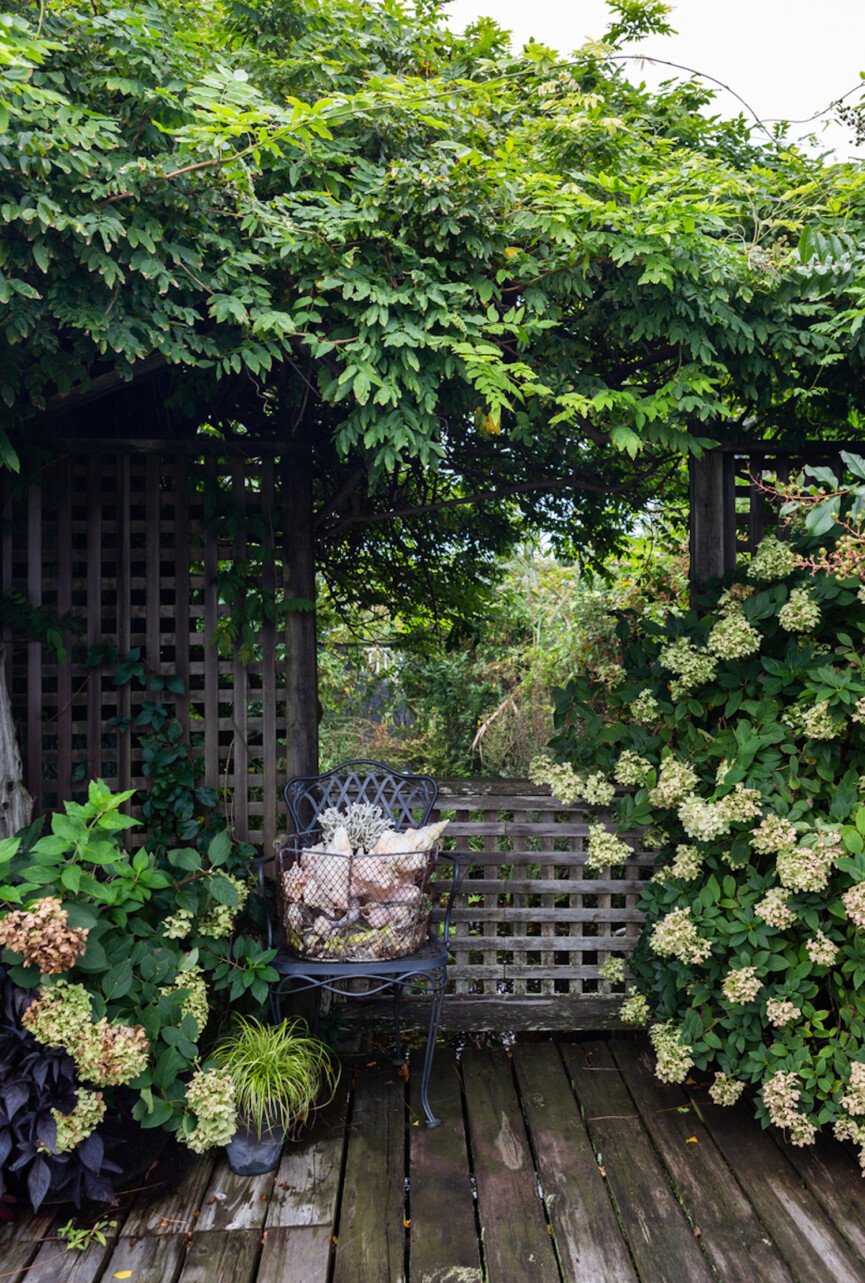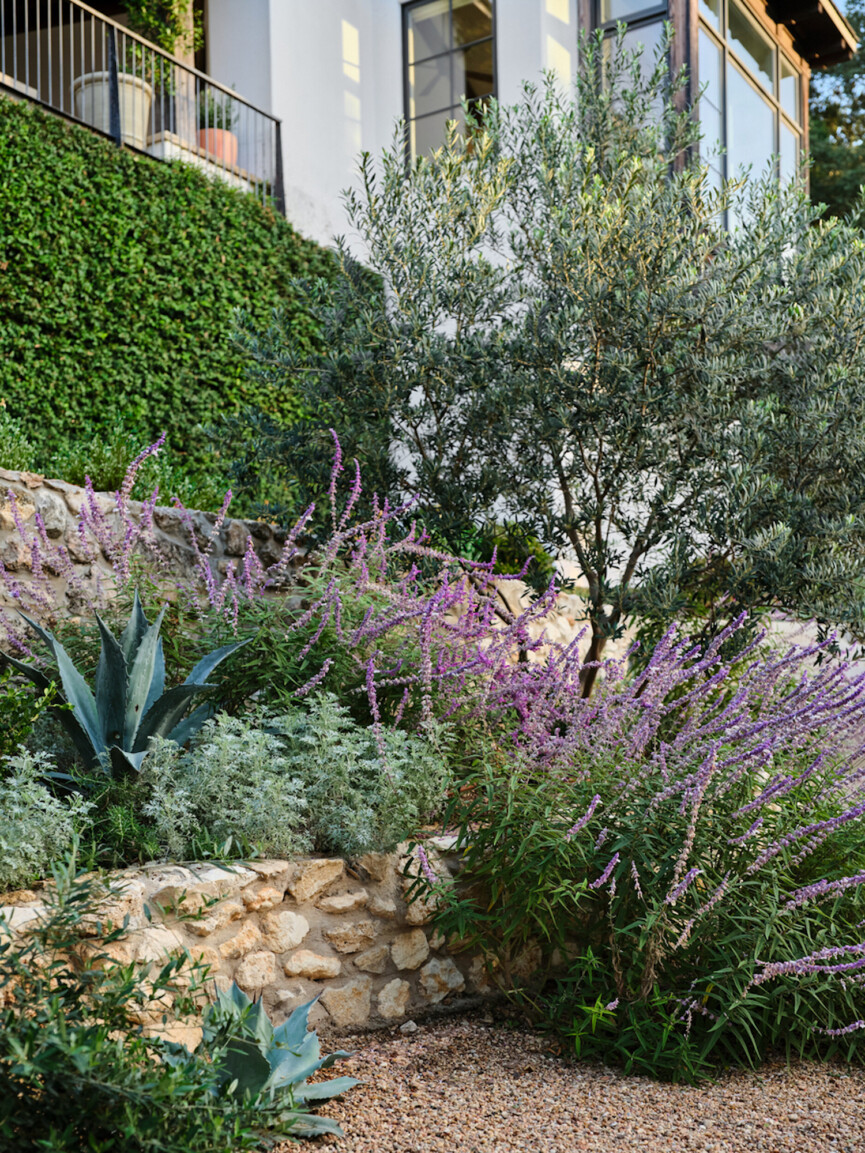One of the simplest pleasures in my life right now is walking through my neighborhood and admiring my neighbor’s hydrangea bushes. Not every house has them, but those that do exude effortless beauty. I’m admiring their blooms of pink or blue flowers because I know hydrangea season won’t last forever. They remind me that color can have an incredible impact, especially when it’s part of your front garden. The lush pink flowers are friendly and inviting. They give off a playful air, while the deep blue hydrangea bushes appear calmer and grounded in their beauty. A garden color scheme clearly sets the tone for your outdoor living space, which is a step you don’t want to skip when planning your garden.
If you want to plant a garden but don’t know where to start, I spoke with Brooke and Leila Giannetti, mother-and-daughter garden designers at Patina Meadow and Madeline, host of the PBS television show Garden Fit · Chat with Madeline Hooper to get her expert tips on garden color schemes. Next, learn how to design your garden with color in mind, and the best color schemes to try yourself!

Where to start when planning your garden
Before heading to the nursery, Gianetti recommends taking a moment to consider the atmosphere you want to create and your intentions for your outdoor space and garden. “Do you want to grow food for your family? Are you trying to create a space that’s primarily for visual interest? Regardless, there are some design tips to keep in mind,” the duo advises.
Just like indoor spaces, they encourage the use of hedges and trees to enclose spaces, such as outdoor rooms. “This creates a feeling of intimacy and privacy, almost like different rooms in the house.” As for choosing plants and flowers for your garden, Hooper says to let your heart lead and don’t overthink it What is right or wrong. “Surround yourself with colors you love,” she says. “Allow yourself to respond to things in your garden that surprise and delight you.”
Hooper also recommends paying attention to what plants and flowers work for your neighbors—meaning your shared conditions work well! Finally, if you’re nervous as a beginner gardener, Hooper encourages you to relieve some stress and have fun. “It really doesn’t matter how you start. You make mistakes. Plants die. You learn through trial and error!” she exclaimed.

Why color palette is important
“A garden color scheme provides unity and coherence to the garden design. It ensures that all elements work harmoniously together to create a space that is not only visually appealing, but also emotionally resonant,” says Giannetti. “A cohesive color palette helps avoid visual clutter and creates a sense of calm and order, which is especially important in a garden for relaxation and enjoyment.”
If you’re not sure what colors look best together, or are simply intimidated by the choice, Hooper suggests you start experimenting. “You don’t have to commit to digging them into the ground,” she commented. Knowing what colors and flowers you like, and the vibe you want your outdoor space to have, will set the tone for creating the garden of your dreams.
“Ultimately, your garden should reflect your tastes and preferences. Choose colors that make you happy and create a space you enjoy spending time in! Giannetti’s addition.
Four garden color schemes we love
You can’t go wrong with the following garden color schemes recommended by Hooper and Giannetti’s. From sweet and pastel to dramatic and bold, choose a color scheme that matches your inner garden and the outdoor space you desire to create.
soft pastels
If you want a garden perfect for afternoon reading, morning meditation or casual dinners, pastel tones will be your dream. “We’re very fond of pastel tones—lilac, pale pink, and soft white. This combination evokes feelings of calm, tranquility, and soothing tranquility,” Gianetti shares. Hooper is also a fan of this palette. “In the garden around my pool, I like to stick to cool, pastel colors paired with watercolors and gray stone head coverings,” she explains.
Hooper loves various shades of pink, blue and yellow and shares that yarrow moonshine, astilbe “peach blossom” and geraniums look more and more beautiful every year in her garden. Giannetti is all about mixing purple with pink or white. “For a soft palette, we use botanicals like lavender and thyme, which not only add beautiful pastel tones but also add a wonderful scent,” they share. “Pair them with pink and white roses or hydrangeas. The key is to keep the color palette limited and focus on texture to add interest.
deep, rich tones
If you value drama and want your home to pop, dark colors may be better for you. Giannetti recommends pairing rich florals with lush greenery. “Dark tulips in spring and rich purple hydrangeas in summer are both excellent choices,” they advise. “Complement these plants with foliage plants like boxwood and yew to add some structure while complementing the color scheme. You can even add blackberry vines to add a functional touch of rich beauty! ”
Of course, blackberry vines produce fruit, and the berries turn from deep red to black when ripe, naturally providing a beautifully rich color palette. Another option? The orange and yellow flowers contrast with the deep purple flowers, making purple and orange an unexpected but beautiful color scheme. Mix gold and orange avens (Geum spp.) or yellow hollyhock Alcea ‘Spotlight’ with purple or crimson scabiosa (or pincushion flower) to create a stunning jewel-toned garden.
monochrome
A garden color scheme does not need to include a variety of colors. In fact, going monochromatic and choosing just one color is a good choice, especially if you have a favorite color. For Hooper, that color is red. “Planting a flower bed or border of one color for a dramatic effect is also a fun challenge, and I’ve had a red-themed flower bed for years that I loved,” she gushes. “It requires more maintenance as I have to replant the Bishop of Llandaff dahlias every season, but they look great with red peonies, Dianthus Telstar Scarlet and Sombrero Salsa Red.”
“Combining different flowers with similar colors — such as the light lilacs of herbs like lavender and thyme, with pink and white rose varieties or hydrangeas — adds depth and variety without being overpowering. Senses,” Giannetti’s note says. As with any garden color scheme, determine the mood you want to create for your garden and choose colors accordingly. A blue garden planted with blue hydrangeas, phlox ‘Blue Boy’ or delphinium ‘Million Dollar Blue’ will bring peace and tranquility. A yellow garden planted with Alchemilla mollis or Baptisia ‘Caroline Moonlight’ will be bright and cheerful.
Remember that a monochromatic garden can contain a variety of shades of the same hue, so don’t be afraid to plan your purple garden with light lavender as well as dark purples that almost look black. “Even with a limited palette, you can create a lot of visual interest through texture,” adds Giannetti.
Rewilding
If you’re interested in a freewheeling maximalist color palette, wilding is a garden trend you’ll love. Also known as meadow landscaping, this garden trend relies on the free growth of native grasses and wildflowers.
“The idea that garden chaos is positive is a big deal,” Hooper commented. “If you want a different color, you can do that and it’ll look great.” If you dream of running through your own wildflower meadow, get a new perspective on what many people typically think of as weeds. “Whatever seeds are in the soil, let them grow,” Hooper advises. “Then keep what you like and eliminate what you don’t like.”
You can conduct a quick search through the National Audubon Society to learn about local specialties in your area. From there, notice what colors and plants you’re drawn to. Because wildness is actually a bit wild, your color palette can be kept simple if you prefer this vibe. Stick to a monochromatic palette and choose flowers of the same hue, or choose up to four different shades for a multi-colored meadow landscape.

